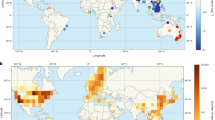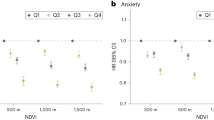Abstract
Risk related to contaminated soil is based on the oral intake of soil and dust among children. This exposure is a consequence of mouthing behaviour, which exposes children to whatever adheres to their hands or toys. This project compared hand exposure of children to lead following outdoor playground activities before and after an intervention. The intervention consisted of replacement of contaminated top soil from the most intensively used playground areas and coverage of bare soil with wood chips or grass. We included children from three kindergartens: one with very low levels of lead in soil and two kindergartens with an average lead concentrations in soil of 100–200 mg/kg. Measurements of lead in soil 5–7 weeks after interventions in two kindergartens verified that the interventions had effectively reduced the potential exposure to lead from the most intensively used areas of the playgrounds. The average lead concentration in soil after intervention was below 10 mg/kg. We found a good agreement between the average concentration of lead in soil and the amount of lead on the hands of the children. Thus, the exposure marker worked and had the advantage compared to a blood sample, that we could evaluate the effect of the interventions shortly after they were accomplished using a noninvasive method. The amount of lead on the hands measured in one of the two kindergartens after the remediation (0.73 μg) was not significantly different from the control kindergarten (0.58 μg). Children from the second kindergarten still had higher median exposures to lead (1.29 μg), but a large overlap existed with several children having lower amounts of lead on their hands than some children from the control kindergarten. Large variations in the amount of lead on hands were observed. Variations may reflect true differences in concentrations of lead in soil, but may also reflect different behavior and playing patterns. Our study demonstrated, that it was possible in a cost-effective way to reduce exposure significantly and to verify the effect with a sensitive, noninvasive method shortly after the interventions had been implemented.
This is a preview of subscription content, access via your institution
Access options
Subscribe to this journal
Receive 6 print issues and online access
$259.00 per year
only $43.17 per issue
Buy this article
- Purchase on Springer Link
- Instant access to full article PDF
Prices may be subject to local taxes which are calculated during checkout

Similar content being viewed by others
References
Aschengrau A., Beiser A., Bellinger D., Copenhafer D., and Weitzman M. The impact of soil lead abatement on urban childreńs blood lead levels: phase II results from the Boston lead-in-soil demonstration project. Environ Res 1994: 67: 125–148.
Gibson J.L. A plea for painted railings and painted rooms as the source of lead poisoning amongst Queensland children. Australas Med Gazette 1904: 23: 149–153.
Hilts S.R., Bock S.E., Oke T.L., Yates C.L., and Copes R.A. Effect of interventions on children's blood lead levels. Environ Health Perspect 1998: 106: 79–83.
Hynes H.P., Maxfield R., Carroll P., and Hillger R. Dorchester lead-safe yard project: a pilot program to demonstrate low-cost, on-site techniques to reduce exposure to lead-contaminated soil. J Urban Health Bull NY Acad Med 2001: 78: 199–211.
Khoury G.A., and Diamond G.L. Risks to children from exposure to lead in air during remedial or removal activities at superfund sites: a case study of the RSR lead smelter superfund site. J Expos Anal Environ Epidemiol 2003: 13: 51–65.
Kimbrough R.D., Le Vois M., and Webb D.R. Management of children with slightly elevated blood lead levels. Pediatrics 1994: 93: 188–191.
Lanphear B.P., Matte T.D., Rogers J., Clickner R.P., Dietz B., Bornschein R.L., Succop P., Mahaffy K.R., Dixon S., Galke W., Rabinowitz M., Farfel M., Rohde C., Schwartz J., Ashley P., and Jacobs D.E. The contribution of lead-contaminated house dust and residential soil to childreńs blood lead levels. Environ Res Sec A 1998: 79: 51–68.
Maynard E., Thomas R., Simon D., Phipps C., Ward C., and Calder I. An evaluation of recent blood lead levels in Port Pirie, South Australia. Sci Total Environ 2003: 303: 25–33.
Rust S.W., Kumar P., Burgoon D.A., Niemuth N.A., and Schultz B.D. Influence of bone-lead stores on the observed effectiveness of lead hazard intervention. Environ Res Sec A 1999: 81: 175–184.
von Lindern I.H., Spalinger S.M., Bero B.N., Petrosyan V., and von Braun M.C. The influence of soil remediation on lead in house dust. Sci Total Environ 2003a: 303: 59–78.
von Lindern I.H., Spalinger S.M., Petroysan V., and von Braun M.C. Assessing remedial effectiveness through the blood lead:soil/dust lead relationship at the Bunker Hill Superfund site in the Silver Valley of Idaho. Sci Total Environ 2003b: 303: 139–170.
Weitzman M., Aschengrau A., Bellinger D., Jones R., Hamlin J.S., and Beiser A. Lead-contaminated soil abatement and urban childreńs blood lead levels. JAMA 1993: 269: 1647–1654.
Acknowledgements
The study was funded by the Danish Environmental Protection Agency, programme on soil and ground water. We are grateful to Ulla Tegner, Anne Abildtrup and Dorrit Meincke for their assistance in collecting and analysing the samples.
Author information
Authors and Affiliations
Corresponding author
Rights and permissions
About this article
Cite this article
Nielsen, J., Kristiansen, J. Remediation of soil from lead-contaminated kindergartens reduces the amount of lead adhering to children's hands. J Expo Sci Environ Epidemiol 15, 282–288 (2005). https://doi.org/10.1038/sj.jea.7500403
Received:
Accepted:
Published:
Issue Date:
DOI: https://doi.org/10.1038/sj.jea.7500403
Keywords
This article is cited by
-
Lead exposure in childhood and historical land use: a geostatistical analysis of soil lead concentrations in South Philadelphia parks
Environmental Monitoring and Assessment (2023)
-
A new screening index to better target low-level lead exposure in Atlanta, Georgia
Scientific Reports (2020)
-
Biochemical changes in the recreational areas soil caused by the intensity of use
Environmental Earth Sciences (2016)



